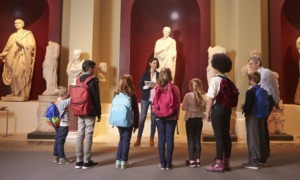In 2009, the American Humanics board of directors moved forward to study changing the organization’s name. Perhaps it would have been easier to have held a contest, changed the name, and moved on. However, bringing the level of thought leadership to the organization itself that it has brought to the nation demanded a more profound approach.
Incorporated into the decision- making process were such considerations as:
Who are the organization’s customers/stakeholders?
What branding strategies should the organization embrace?
What value the organization brings to its stakeholders?
Since 1948, the name American Humanics has been emblematic of the idea that linking the education of students to the needs of such organizations like the Boy Scouts, the YMCA and others was a wise investment.
It was difficult to know exactly why founder H. Roe Bartle used the term Humanics. The word, after all, was not in the dictionary. The closest I got was “humanism”. I found that the word, humanism, dates back to the early 1800’s serving as a descriptor for both a devotion to the field of humanities as well as a description for values that embrace a belief in the worth of all mankind, and the ability of all to realize excellence.
H. Roe Bartle’s life and career in service had an enormous impact. His Boy Scouts career, service as mayor of Kansas City, national presidency of Alpha Phi Omega and the fact that he served as president of Missouri Valley College, underscored that this was not an easy decision. Many were invested in this man, his ideals and the name he gave to this organization. This was a decision that invited passionate argument. Historians, donors, alumni, friends and more were going to be affected or at least had the potential of having something to say.
The board’s marketing and communication committee was charged with leading the name change. This board has a very strong committee structure and trusts that committees have done their due deliberation before bringing an issue or decision to the full board. Fortunately, a board member who owns a marketing and communications firm had made the commitment to provide the expertise of his firm pro bono.
The first thing his firm did was research the organization’s customers. From surveys and focus groups, gaining knowledge of what was important to students and campus program leaders was seen as critical. Understanding their values provided a foundation for understanding what words could be used in naming the organization and determining a new tag line. Not only did the firm conduct the research they also provided the intellectual capital needed to interpret the information gained, comparing it to other national branding and rebranding efforts.
During the course of more than a year, the information gained was discussed by the marketing and communication committee. They led the board’s discussion of the research conducted. By the time the board began to consider new names for the organization, they also were in the process of hiring me as the organization’s new president, and an already challenging process then got a little more complicated. To the board’s credit, they facilitated meetings between myself and the board member’s firm. The process of decision-making was extended for almost six months past the board’s projected timeline.
The decision to allow the new CEO to inform the process of decision-making was not easily made. Many constituents had been involved and there was anticipation of the outcome. There was a great deal of investment in this process by a lot of people.
I came from a community college background, and therefore my perspective was that the new name had to acknowledge that the very definition of the words college student has changed. No longer are the organization’s affiliated programs preparing 17- to 22-year-olds, they are also enrolling some of those currently unemployed who are seeking to find jobs in the nonprofit sector.
This perspective presented some challenges that needed to be worked out. Younger, traditional age students value different words than baby boomers and even the millennial generation, those in their 40s and early 50s.
What complicated the process even more was the opinion of the organization’s attorneys. Copyrighting and protecting the organization’s new name was something that was not only important, but actually played a significant role in the choice to be made. The attorney’s advice was that descriptive names are harder to protect. The attorneys stated that names like American Humanics, more abstract names, were easier to protect.
This provided some angst for the board. But ultimately, they decided that giving the organization a name that was descriptive of its work would be the focus, which then underscored that achieving a new understanding of the organization’s work needed to occur.
Through the process all came to realize that this was not simply changing the name of an organization on company letterhead or plaques. This was truly evolving the image of an organization. This was about achieving currency in the market place. It was through sound business practices, including the process of study and decision-making that led to not just changing the organization’s name, but to the recognition that changing the name was just the beginning of the journey to transform the organization.
In March 2010, the American Humanics board of directors voted unanimously to change the name of the organization to the Nonprofit Leadership Alliance. Now the link between the organization’s name and its mission is unmistakable.
Wayne Branch is president of The Nonprofit Leadership Alliance, which is the only national alliance of colleges, universities, nonprofit organizations and corporate leaders dedicated to educating, preparing and certifying professionals to strengthen and lead nonprofit organizations. The organization’s first significant endeavor under its new name will be to publish the results of the first-ever, comprehensive national survey assessing the competencies required by the nonprofit sector.






























